Battle of Kessler's Cross Lanes
Introduction
Text-to-speech Audio
The Battle of Kessler’s Cross Lanes, which is also known as the Battle of Cross Lanes, happened on August 26, 1861 in present day Nicholas County, West Virginia. The Confederate Brigadier General John B. Floyd crossed the Gauley River to attack Erastus Tyler’s Union forces camped at Kessler’s Cross Lanes. The Union forces were surprised and Floyd’s troops won the battle. Visitors to the site of the battle can see an informational historical marker and a Civil War era cemetery.
Images
Cross Lanes Battle historical marker
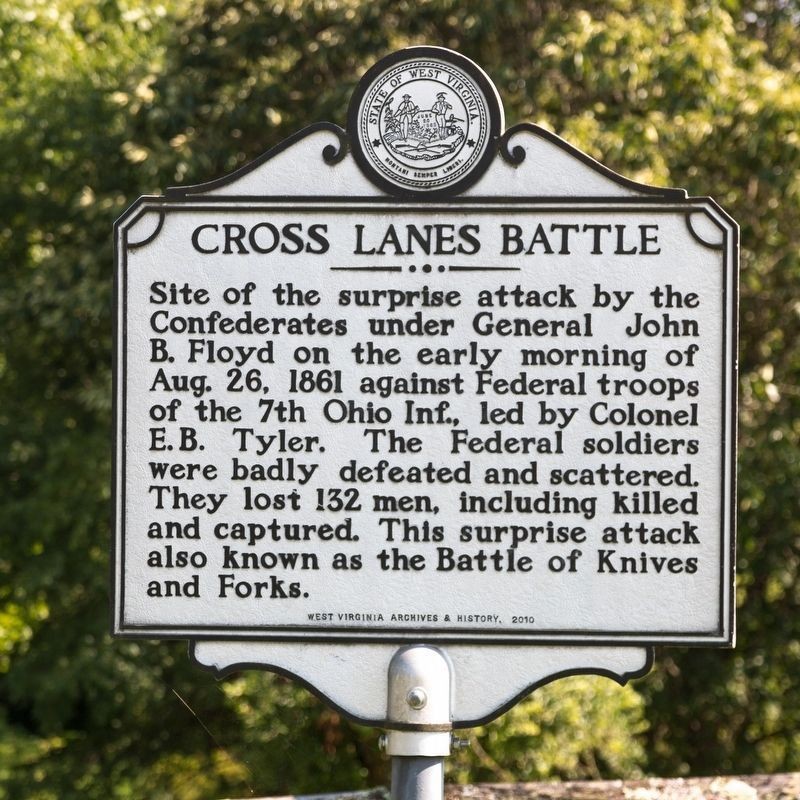
"Colonel Tyler's Camp, Near Summersville, Va."
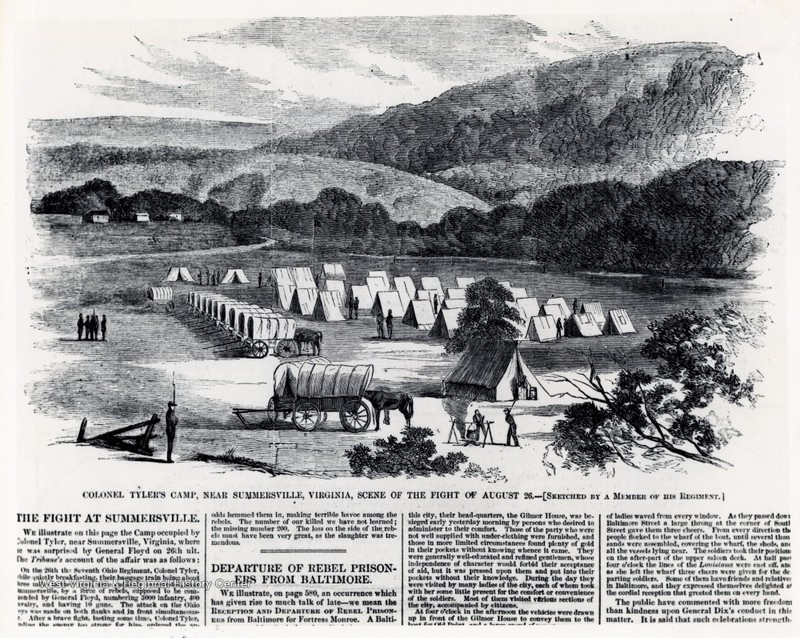
Map of the Battle of Kesslers Cross Lanes drawn by Lieutenant T.T. Sweeney
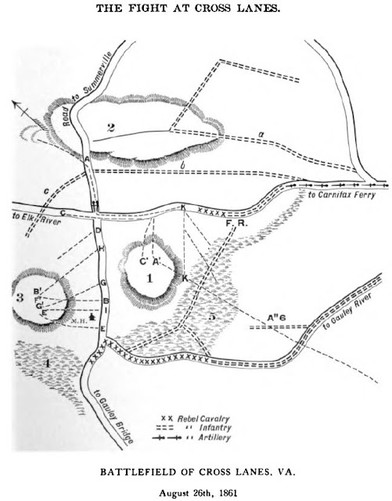
Colonel Erastus B. Tyler, commanding 7th Ohio Infantry
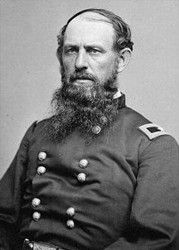
Lieutenant Colonel William R. Creighton
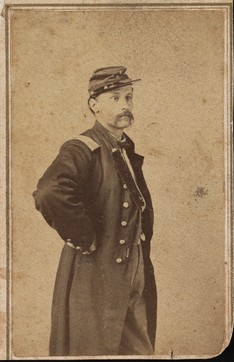
Captain Orrin J. Crane, Company A, 7th Ohio Infantry
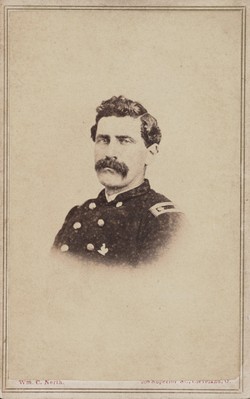
Captain Giles Waldo Shurtleff, Company C, 7th Ohio Infantry
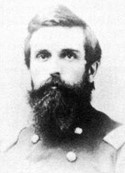
Major John S. Casement, photo from c. 1870
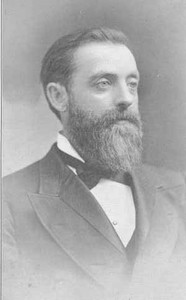
Chaplain Frederick Brown
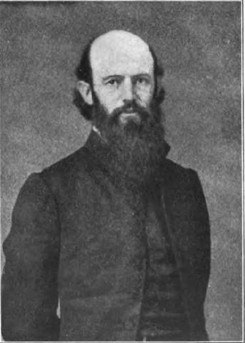
Confederate General John B. Floyd
.jpg)
Colonel Christopher Q. Tompkins, 22nd Virginia Infantry
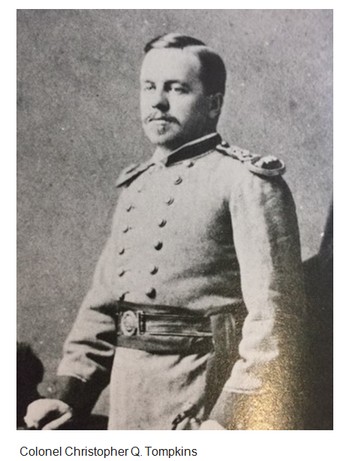
Colonel John McCausland, 36th Virginia Infantry
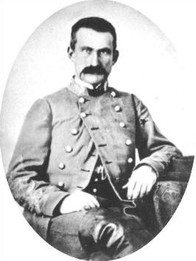
Colonel Henry Heth, commanding 45th Virginia Infantry
.jpg)
Colonel Alexander Welch Reynolds, 50th Virginia Infantry
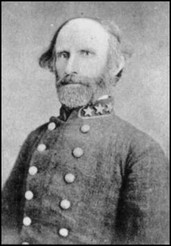
Zoar Baptist Church. The current church building was constructed in 1955 after a fire.
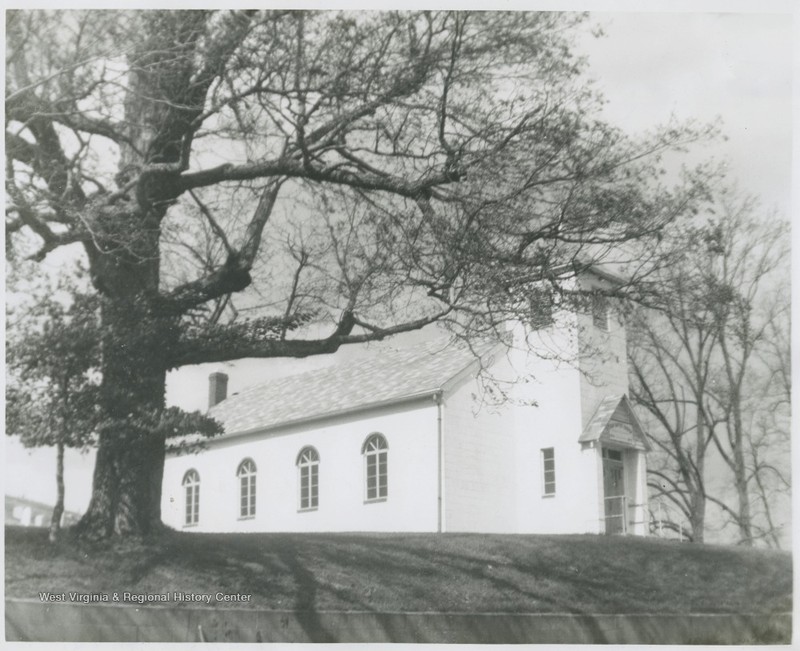
Backstory and Context
Text-to-speech Audio
After the first western Virginia campaign of May-June 1861 the Confederate forces had been driven out of the Tygart and Kanawha Valleys, claiming the western region for the Union. As the summer of 1861 progressed the Confederates wanted to retake the Kanawha Valley and then push north towards Wheeling to regain control of the region. Confederate Virginia was very concerned with maintaining control over the western portion of the state as Unionists were already moving forward with establishing a loyal government. The Reorganized Government at Wheeling had already been recognized as the legitimate government of Virginia by the Lincoln administration and this government was working to secure new Unionist senators in Congress and raise Union regiments to fight in the war. By summer of 1861 the Confederates were facing the loss of western Virginia both militarily and politically.
Union General George McClellan had commanded the successful summer 1861 campaign, but he had been called to Washington after the Union defeat at First Manassas to reorganize the Army of the Potomac. Command of the operations in western Virginia passed to Brigadier General William S. Rosecrans. For the Confederates, Major General Robert E. Lee was given his first field command and arrived in western Virginia on August 1st. The Union had a defensive line that extended from Gauley Bridge to Cheat Mountain and then north to the Potomac to protect important transportation routes and secure the western portion of the state from Confederate control. When Lee assumed command there were several Confederate forces operating around the Kanawha Valley. The first was a Confederate force under Brigadier General W. W. Loring facing a Federal force under General Joseph J. Reynolds around Cheat Mountain. Further south in the Greenbrier region there were two Confederate forces under Brigadier General John B. Floyd and Brigadier General Henry A. Wise maneuvering around Union Brigadier General Jacob D. Cox’s force near Gauley Bridge.
The Gauley River was an important protective feature to the Union line, especially the line of communication linking Cox at Gauley Bridge to Rosecrans who was stationed at Clarksburg. The Gauley was largely uncrossable except for a few places due to steep cliffs and rapids. Carnifex Ferry was one of those crucial crossings over the Gauley. Located at the confluence of the Gauley and Meadow River where there was a wider section of smooth water, Carnifex Ferry was a main connector from the Lewisburg Pike (the James River and Kanawha Turnpike) to the east into the Kanawha Valley. On the western side of the ferry, the road intersections near Kessler’s Cross Lanes connected Gauley Bridge in the south to Summerville and the north and then Carnifex Ferry west to the Elk River. Cross Lanes was crucial to controlling the road network into the Kanawha Valley and western Virginia.
Floyd’s campaign plan was to use his and Wise’s forces to oppose Cox’s Union force at Gauley Bridge, push the Union troops out of the Kanawha Valley, move west towards Ohio, and then move up the Ohio River towards Wheeling to disrupt the meetings of the Unionist government. There was a referendum scheduled for October 24, 1861 concerning the western part of the state separating to become a new Unionist state and the Confederates wanted to regain control over western Virginia and disrupt that movement. By mid-August Cox was receiving intelligence that Confederate forces were maneuvering—this would have been the forces of Wise and Floyd gathering near White Sulphur Springs. Rosecrans had a small force stationed at Summersville to patrol and protect the road networks and on August 13th Rosecrans ordered the 7th Ohio (commanded by Colonel E. B. Tyler) to Cross Lanes to guard the intersection there. The regiment held their position for five days until Cox called them to move closer to Gauley Bridge on August 20th. With Floyd and Wise moving closer, Cox was worried they were planning an assault on Gauley Bridge and he moved the 7th Ohio to Twenty Mile Creek to reinforce his position.
The 7th Ohio would soon return to Cross Lanes, but in the time that they were gone Floyd crossed the Gauley with his troops. On August 21st, with intel that the Union force had left, he had his troops raise the ferry boats that the Union had previously scuttled and crossed his troops at Carnifex Ferry. Floyd began to entrench on the cliffs in the horseshoe bend of the Gauley. Wise did not join Floyd with his force. Floyd and Wise were both political appointees, both ex-governors of Virginia, and they did not like each other or work well together. Wise did not approve of the position that Floyd was taking up and he refused to cross the Gauley. Instead, Wise took his troops to Hawks Nest to threaten Cox at Gauley Bridge and prevent the Union force from moving on Floyd. Once Cox knew that Floyd had crossed at Carnifex Ferry he ordered the 7th Ohio to return to Cross Lanes and they began their march back on August 24th.
After the 7th Ohio crossed Peters Creek on August 24th, they received intelligence that Floyd’s army had fully crossed the Gauley. The regiment went into camp at Peters Creek Ford for the night. Early the next morning nine companies from the 7th Ohio moved towards Cross Lanes, leaving Company F to guard the supply train. Also remaining with Company F was a partisan ranger group commanded by Captain John P. Baggs called the “Snake Hunters.”
At the intersection of the Peters Creek and Cross Lanes roads five companies remained at the fork, one traveled up the north branch, and three went down the southern branch towards Cross Lanes. These three companies under Lieutenant Colonel William E. Creighton marched about 7 miles to approach Cross Lanes around 5:00pm. At Cross Lanes, the 7th Ohio discovered about 40 Confederate cavalrymen and Company A under Captain Orrin J. Crane attacked and drove the cavalrymen out of Cross Lanes. After clearing the Confederate cavalry and a few pickets out of the area, Colonel Tyler felt that the intersection was secured and called up the remainder of his companies (except Company F and the “Snake Hunters” who remained with the supply train).
Tyler positioned Company A (commanded by Captain Orrin J. Crane) just east of the intersection on Malcom Heights, the long knoll that runs parallel to Meadow Creek). Company C (commanded by Captain Giles Waldo Shurtleff) was nearest to the intersection and used both the Vaughan house and country store as housing. Company K (commanded by Lieutenant Colonel C. F. Nitchelm) was deployed as skirmishers on the road towards Carnifex Ferry, less than a mile away from the Cross Lanes intersection. The remaining companies were positioned on the road towards Peters Creek, between the intersection and the Zoar Baptist Church, with Company B closest to the intersection and then companies, D, E, G, H, and I in that order towards the church. Colonel Tyler used the Zoar Baptist Church as his headquarters. In the case of an attack, companies A, C, and K were to fall back to the intersection to join the other companies in defending the road to Peters Creek. With Floyd only three miles away at “Camp Gauley” there has been debate whether Tyler did adequate reconnaissance or established the necessary defenses on the night of August 25th.
While Tyler’s 7th Ohio settled into their positions for the night, Floyd’s Confederate scouts took note of the Union camp and reported back to “Camp Gauley.” Floyd planned an attack on Cross Lanes for the morning and assembled the 22nd Virginia Infantry, 36th Virginia Infantry, 45th Virginia Infantry, 50th Virginia Infantry, and Lieutenant Thomas E. Jackson’s Horse Artillery.
On the morning of August 26th the 7th Ohio prepared breakfast and was eating when Floyd’s force attacked. The Confederates came from the left of Company K’s position and they advanced towards Malcom Heights. The surprise attack quickly scattered Company K and the other companies scrambled to fall into line. From his headquarters at the church, Tyler took command of the companies along the road. Lieutenant Colonel William E. Creighton, Major John S. Casement, and Sergeant Major Leicaster King took Companies A and C from the intersection and moved them forward to support Company K. As the two companies moved up the road the Confederates emerged on their left, outflanking the Union men. Major Casement ordered the two companies to the right of the road to two hills to make a better defensive position. This meant having the men climb over a fence and cross over open fields under fire to get to the high ground. While Companies A and C started towards the right, Major Casement rode back to the intersection with Chaplain Frederick Brown to call up reinforcements, but the companies in the road had begun to panic and Casement could not get troops to move forward.
Companies A and C made it to the hill along with parts of Company K who had broken and fallen back. Company C was positioned on the left of the hill and made a stand against the approaching Confederates for about 10 minutes. Company A on the right noticed a Confederate unit in their rear. The Confederates had used an obscured wooden path and were approaching the Union regiments by the church from behind the hill. Company A engaged with this unit and managed to capture their colors.
While Companies A and C were engaged at the hill, Floyd moved his artillery up and opened fire on the companies in the road. Company D (commanded by Captain John Dyer) followed by Company H advanced towards the intersection to counter the Confederate troops but as soon as they emerged into the cleared field they were hit hard by Confederate fire. The Confederate momentum ultimately pushed companies D, H, and remnants of Company K into retreat to the woods behind the Zoar Baptist Church. Captain Dyer was shot during the retreat of his company. He was carried to the Vaughan house where women from the Vaughan and Malcom families tended to him, but he died from his wound.
With his surprise attack on the morning of August 26, Floyd handily demolished the 7th Ohio. Company C, fighting on the high ground ahead of the main line, was quickly in danger of being outflanked and tried to retreat into the woods behind their position. They attempted to get through the woods on route to Gauley Bridge but they were captured by the 22nd Virginia. Colonel Tyler, Lieut. Col. Creighton, and around 50-60 men were able to retreat from the hill by the Zoar Baptist Church with the help of Chaplain Brown who was familiar with the area. This small group rejoined Company F and the “Snake Hunters” at the supply train and made it back to Brig. Gen. Cox at Gauley Bridge to report on the defeat. When Tyler arrived back at Gauley Bridge only his group of 50-60 men had made it back, but others did start to trickle in from other escape routes. That evening Captain Crane and Lieutenant Albert C. Burgess arrived with around 60 men of Company A and then next day several individuals and small groups straggled into the Union camp. Two days after Cross Lanes news reached Tyler that Major Casement and 400 more men of the regiment had made it safely to Charleston. The disaster at Cross Lanes was not a bad as it initially seemed during the retreat. The final casualty count for the 7th Ohio was 2 killed, 29 wounded (some of which would died later of their injuries), and 110 captured (9 of them wounded).
Floyd and his Confederates did not pursue the 7th Ohio too far past Cross Lanes, choosing instead to claim the victory and return to “Camp Gauley” where his army continued to entrench. The Vaughan, Hamilton, and Malcolm houses and the Zoar Baptist Church were turned into hospitals for the wounded and the dead were buried near the intersection (the bodies were later removed). The captured 7th Ohio soldiers were brought to “Camp Gauley,” where some were recovered by the Union after the Battle of Carnifex Ferry.
After the disaster at Cross Lanes and with Floyd entrenching at Carnifex Ferry, Union General George McClellan (commanding the Army of the Potomac in eastern Virginia) became concerned that all the Union gains from earlier in the summer would be lost. The Confederates had cut the communication lines between Cox and Rosecrans and taken possession of the main transportation route into the Kanawha Valley. He commanded Rosecrans to respond to the Floyd/Wise threat and on August 29 ordered Rosecrans to coordinate with Cox to trap Floyd and remove the Confederate threat. Rosecrans started to gather troops at Sutton on September 2 and moved south towards Summersville on September 7. This set into motion the events that would result in the Battle of Carnifex Ferry on September 10, 1861.
Sources
Lesser, W. Hunter. Rebels At the Gate: Lee and McClellan on the Front Line of a Nation Divided. Naperville, IL: Sourcebooks, Inc., 2004.
Lowry, Terry. September Blood: The Battle of Carnifex Ferry. Charleston, WV: Quarrier Press, 2011.
Shaffer, Dallas B. “The Battle at Carnifex Ferry.” State of West Virginia. Produced by the Department of Natural Resources, Division of Parks and Recreation. C. 1963.
Snell, Mark A. West Virginia and the Civil War: Mountaineers Are Always Free. Charleston, SC: The History Press, 2011.
Stutler, Boyd B. West Virginia in the Civil War. Charleston, WV: Education Foundation, Inc, 1966.
"Cross Lanes Battle." The Historical Marker Database. Accessed May 31, 2022. https://www.hmdb.org/m.asp?m=76621.
"Colonel Tyler's Camp, Near Summersville, Va." West Virginia History OnView. West Virginia & Regional History Center. Accessed May 31, 2022. https://wvhistoryonview.org/catalog/033614.
"The 'Bloody Seventh Ohio' at Cross Lanes." Dan Masters' Civil War Chronicles. September 9, 2020. Accessed May 31, 2022. https://dan-masters-civil-war.blogspot.com/2020/09/the-bloody-seventh-ohio-at-cross-lanes.html.
"Erastus B. Tyler." Wikipedia. Accessed May 31, 2022. https://en.wikipedia.org/wiki/Erastus_B._Tyler.
Silsbee, Case & Co, Ryder, J. F, photographer. Colonel William R. Creighton of 7th Ohio Infantry Regiment in uniform / J.F. Ryder, photographist. United States, None. [Cleveland, o.: j.f. ryder, photographist, 171 superior str., between 1861 and 1863] Photograph. https://www.loc.gov/item/2016649614/. Accessed May 31, 2022.
North, William Case, photographer. Lieutenant Colonel Orrin J. Crane of Co. A, 7th Ohio Infantry Regiment in uniform / Wm. C. North, 205 Superior St., Cleveland, O. United States, None. [Cleveland: wm. c. north, 205 superior st., between 1861 and 1863] Photograph. https://www.loc.gov/item/2018651874/. Accessed May 31, 2022.
"BG Giles Waldo Shurtleff." Find A Grave. Accessed May 31, 2022. https://www.findagrave.com/memorial/11761320/giles-waldo-shurtleff.
"John S. Casement." Wikipedia. Accessed May 31, 2022. https://en.wikipedia.org/wiki/John_S._Casement.
"The 'Bloody Seventh Ohio' at Cross Lanes." Dan Masters' Civil War Chronicles. September 9, 2020. Accessed May 31, 2022. https://dan-masters-civil-war.blogspot.com/2020/09/the-bloody-seventh-ohio-at-cross-lanes.html.
"John B. Floyd." Wikipedia. Accessed May 31, 2022. https://en.wikipedia.org/wiki/John_B._Floyd.
Gauley David. "Mistress of the Mansion, Ellen Tompkins of West Virginia's Gauley Bridge: Caught Between Two Opposing Armies." Medium. November 17, 2019. Accessed May 27, 2022. https://medium.com/@gauley.david/mistress-of-the-mansion-ellen-tompkins-of-west-virginias-gauley-bridge-caught-between-two-cc9c9dfc53d.
"John McCausland." Wikipedia. Accessed May 27, 2022. https://en.wikipedia.org/wiki/John_McCausland.
"Henry Heth." Wikipedia. Accessed May 31, 2022. https://en.wikipedia.org/wiki/Henry_Heth.
"Alexander W. Reynolds." Wikipedia. Accessed May 27, 2022. https://en.wikipedia.org/wiki/Alexander_W._Reynolds.
"Zoar Baptist Church, Keslers Cross Lanes, Nicholas County, W. Va." West Virginia History OnView. West Virginia & Regional History Center. Accessed May 31, 2022. https://wvhistoryonview.org/catalog/051125.
